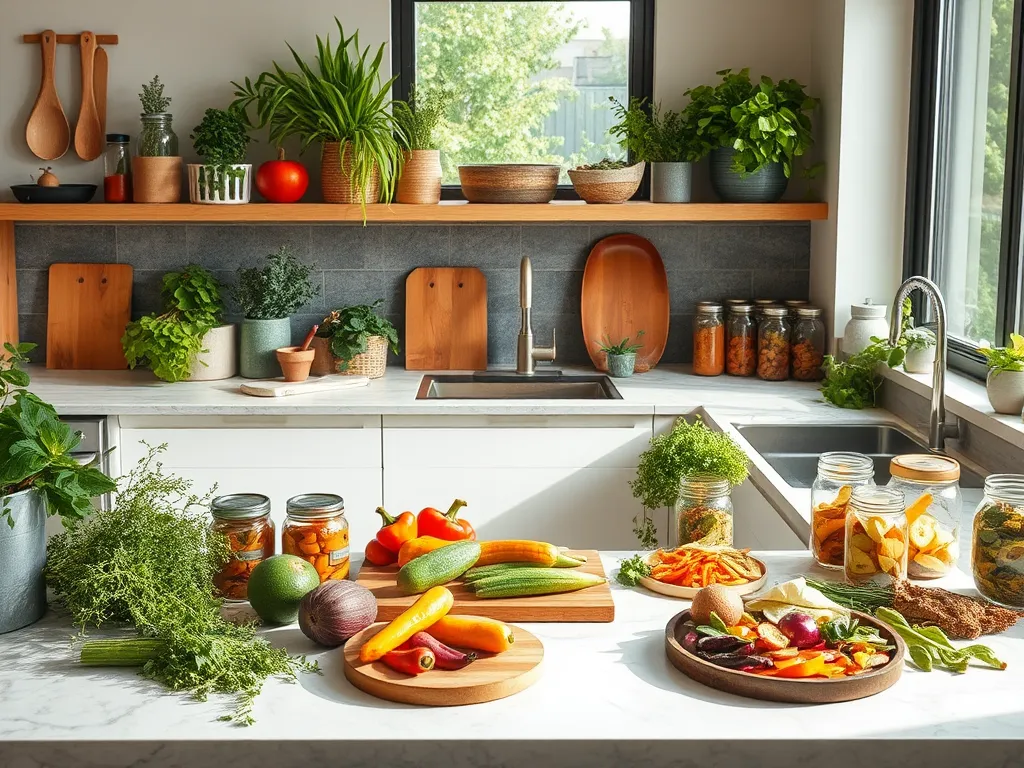Zero Waste Cooking: Innovative Tips for Calgary Kitchens

Zero Waste Cooking: A Sustainable Approach to Food Preparation
Zero Waste Cooking is an innovative culinary practice that emphasizes the reduction of food waste at every step of the cooking process. By utilizing every part of an ingredient, from peels to stems, and creatively repurposing leftovers, this method not only promotes sustainable living but also encourages a more mindful approach to food preparation. In a world where food waste contributes significantly to environmental issues, adopting Zero Waste Cooking practices can make a substantial positive impact.
One of the pillars of Zero Waste Cooking is the commitment to thoughtful consumption. This means carefully planning meals, shopping with a list, and avoiding impulse purchases that often lead to food waste. The practice encourages cooks to be resourceful, using every morsel of food available, which can lead to exciting new culinary discoveries and a more engaged cooking experience. It also fosters a greater appreciation for the ingredients, as each item is valued, regardless of its perceived usefulness.
Furthermore, Zero Waste Cooking teaches us that much of what might traditionally be viewed as waste can instead be transformed into delicious meals or useful ingredients. For example, vegetable scraps can be used to make stocks, stale bread can be turned into croutons, and overripe fruits can be baked into muffins or blended into smoothies. This philosophy not only enhances creativity in the kitchen but also instills a sense of responsibility towards reducing food waste.
Another significant aspect of Zero Waste Cooking is its focus on the benefits of sustainability. By minimizing waste, we reduce the carbon footprint associated with food production and disposal. Moreover, it encourages individuals to support local food systems by purchasing seasonal produce, which is often fresher and more nutritious. The community aspect of cooking—sharing knowledge, recipes, and resources—also strengthens the bond between individuals and their localities, promoting a collective effort towards sustainable practices.
Ultimately, Zero Waste Cooking is not just about minimizing waste; it’s a holistic approach that encompasses environmental stewardship, community engagement, and creative culinary practices. It pushes cooks to rethink their relationship with food and to embrace a sustainable lifestyle, making a significant difference, both in the kitchen and beyond.
Benefits of Zero Waste Cooking
One of the most compelling benefits of Zero Waste Cooking is its positive environmental impact. By reducing food waste, we can decrease the amount of food that ends up in landfills, where it contributes to methane emissions—one of the most potent greenhouse gases. According to studies, approximately one-third of all food produced globally is wasted, making it essential to adopt strategies to minimize this waste. By employing zero waste techniques, not only do we preserve valuable resources, but we also contribute to a healthier planet.
In addition to environmental benefits, Zero Waste Cooking can significantly affect financial savings. By utilizing ingredients more efficiently and minimizing waste, individuals can reduce their grocery bills. Meal planning, using leftovers, and repurposing unused ingredients into new meals can maximize the value of each dollar spent on groceries. This approach teaches careful spending habits and encourages smarter shopping practices, ultimately leading to fewer expenses related to food waste disposal.
From a nutritional standpoint, Zero Waste Cooking offers several advantages as well. When cooks utilize leftover ingredients and plant scraps, they often incorporate a wider variety of foods into their diets, which can enhance nutritional intake. For example, using beet greens or carrot tops can boost the intake of vitamins and minerals. Furthermore, cooking with fresh, seasonal ingredients reduces the consumption of processed foods, leading to healthier eating habits over time.
Zero Waste Cooking Techniques
One essential technique in Zero Waste Cooking is finding creative uses for food scraps and peels. For instance, citrus peels can be used to infuse flavor into dishes, while vegetable scraps can be repurposed into flavorful stocks or compost. Other clever uses include making pesto from radish greens or chips from kale stems. By thinking outside the box, cooks can create delectable dishes while minimizing waste.
Batch cooking and meal planning strategies are crucial for successful Zero Waste Cooking. Planning meals in advance helps minimize the likelihood of impulse buys, and cooking in large quantities means that leftovers can be easily transformed into new meals. For example, a roasted chicken can provide meat for sandwiches, salads, and soups throughout the week. This technique not only saves time and energy but also promotes a more environmentally conscious approach to meal preparation.
Effective storage methods play a pivotal role in avoiding spoilage and prolonging the life of ingredients. Using airtight containers, vacuum sealing, and proper refrigeration can help maintain the freshness of food and prevent waste. Labeling items with expiration dates and organizing the fridge can also streamline the cooking process by ensuring that older items are used first, thereby reducing the potential for spoilage.
Local Resources for Zero Waste Cooking in Calgary
In Calgary, several community organizations are devoted to promoting Zero Waste initiatives. These organizations often host workshops, provide resources, and facilitate events that educate the public on reducing food waste. Additionally, many local food banks and charities accept surplus food donations, further enabling residents to contribute to the community while reducing waste.
Farmers' markets in Calgary offer an excellent opportunity for zero waste cooking by providing access to fresh, seasonal produce. Shopping directly from local farmers reduces the carbon footprint associated with transportation and packaging, and it often results in higher-quality ingredients. Many markets also encourage shoppers to bring their own bags and containers, reinforcing the zero waste philosophy in everyday shopping practices.
Calgary is home to several zero waste grocery stores that specialize in bulk buying and minimal packaging. These stores often sell food items without single-use plastic, allowing consumers to bring their own containers and reduce waste significantly. By supporting these local businesses, consumers can actively participate in the movement towards a more sustainable and eco-friendly food system.
Zero Waste Kitchen Tools and Gadgets
Essential kitchen tools for minimizing waste include reusable produce bags, airtight glass containers, and compost bins. Investing in high-quality, durable utensils will also ensure they last longer, reducing the need for replacements. Moreover, utilizing kitchen gadgets such as blenders and food processors can aid in transforming scraps into new meals, showcasing the versatility of ingredients while minimizing waste.
Eco-friendly kitchen gadgets that support Zero Waste Cooking are increasingly popular. Items such as beeswax wraps for food storage, silicone bags for freezing, and bamboo utensils are practical and sustainable alternatives to single-use plastic options. These gadgets not only help reduce waste but also promote a more environmentally conscious cooking environment.
When choosing sustainable cookware, look for products made from non-toxic materials, such as stainless steel, cast iron, or ceramic. These materials are long-lasting and reduce the need for frequent replacements. It's essential to consider the environmental impact of the manufacturing process and select companies that prioritize ethical practices and sustainability in their production methods.
Recipes for Zero Waste Cooking
Simple recipes using leftovers are the heart of Zero Waste Cooking. For example, a vegetable stir-fry can be a great way to utilize wilting vegetables, while a frittata can incorporate any leftover meats or vegetables from previous meals. Simply transforming what might be deemed 'waste' into a new dish encourages ingenuity and minimizes food loss.
Seasonal recipes with local produce align perfectly with Zero Waste Cooking principles. Utilizing what's in season not only enhances flavor but also supports local farmers. For instance, a summer salad can highlight fresh tomatoes, cucumbers, and herbs, while a winter stew can make use of root vegetables. These recipes emphasize the joy of cooking with fresh ingredients, reinforcing the connection to local food sources.
Zero waste baking ideas also offer creative solutions for using leftover ingredients. For instance, stale bread can be used for breadcrumb topping or bread pudding, while overripe bananas are perfect for muffins or smoothies. These recipes not only minimize waste but also showcase the versatility and deliciousness of ingredients that may otherwise be discarded.
